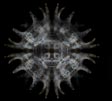|
||
|
Shells are objects which, for thousands of years, have accompanied man. The discovery of Prehistoric tombs where shells and stones of a particular form have been found proves that shells were probably amongst the first objects that the homo sapien surrounded himself with for aesthetic contemplation. In a certain sense, shells are amongst the first artistic operas of man, where art can be understood as the sole action of choosing an object belonging to reality and considering it worthy of being conserved. The history of art, before becoming a history of ideas and movement, is precisely this: a story of objects that, miraculously, have emancipated during the process of usage becoming objects of care and attention due to the admiration they provoke. Shells, therefore, became works of art before man was able to create his own artistic forms. It may be for this reason that the shells, with all their innumerable forms and colours, are a source of inspiration, whether formal or decorative, for art and architecture. And not only. A certain type of shell called the Murex Brandaris, that belongs to the family of the Purpuridae, was used for its famous and widely sought after colour in ancient times: purple. It cannot be excluded either that when porcelain was invented in China between 700 and 800 ad., the production of a white and bright substance similar to mother of pearl was highly important. Amongst the photographs presented in this gallery, I have tried to create a compendium of the forms and colours that inspired humanity. Maybe it is for this reason that whilst we observe these marvellous objects, we seem to recognise a beauty which already belongs to us. |
||






























